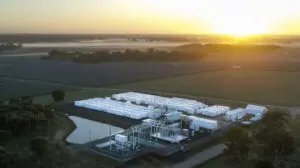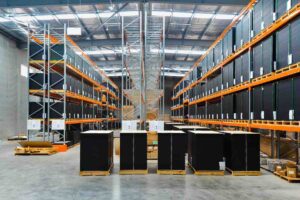There were some really good lines delivered by some of the key players in the industry at the Australian Clean Energy Summit in Sydney this week.
“It’s like trying to eat an elephant in half an hour,” Australian Renewable Energy Agency boss Darren Miller said of the pace of the transition to renewable energy. Or, as Australian Energy Market Operator CEO Daniel Westerman put it: “It requires our industry to redesign and rebuild the aeroplane while we’re flying it.”
But there’s one big problem. Australia’s electricity transition – despite all the targets, the modelling, the scenarios and the big talk of investing in massive projects – is slowing to a crawl.
There was just 0.4GW of new investment financed in the first half of 2023, according to the Clean Energy Council, a fraction of the 5GW needed to meet the country’s 82 per cent renewables target, itself a crucial stepping stone to the country’s economy wide target of a 43 per cent cut in emissions by 2030.
That slowdown in investment is due to a bunch of different issues: The lack of transmission, the complexity and cost of connection agreements, social licence issues, volatile markets, and rising costs of materials and finance in an inflationary world. Investors are nervous, and hesitant.
Easy to say
So there was little surprise that the central theme and the recurring refrain at the conference – from the opening speech of CEC CEO Kane Thornton to the closing session – was how to solve the problem: “Extend the RET.” The renewable industry has a new battle cry.
Extend the RET might be easy to say, but it could be hard to do – for a whole bunch of reasons, many of them political.
The Renewable Energy Target has, of course, been a political football since it was first created by the Howard government nearly two decades ago. It was so successful in its first iteration – well, it got the country’s grid to more than 1 per cent wind – that it was quickly shut down at the urging of the fossil fuel industry.
The Abbott government tried to repeat the dose a decade later, but was thwarted by the Greens and aspiring coal baron and then elected politician Clive Palmer, of all people, who was flattered by Al Gore just long enough to vote for a reduction, rather than a repeal, of the RET in the Senate.
That slimming down of the RET still left the industry plenty to do: Deliver 33 terrawatt hours of new generation by 2020. The naysers and the Opposition (excuse the tortology) said it couldn’t be done. But of course it was, and with some margin to spare.
Weird markets
Since then, something weird has happened to the market.
The price of the RETs renewable energy certificates were predicted to fall to zero, but they didn’t – partly because Australian business has bought up a whole bunch and then repealed them as part of their commitments – non negotiatable for their international customers – to slash emissions and have green power.
That is good. But what’s not good is that even with the unexpected price lift in certificates, there is still no mechanism to provide the long term investment signal the industry craves for 20 and 30-year assets.
Federal energy minister Chris Bowen is convinced that the renewables target can still be met, as he told RenewEconomy’s award winning Energy Insiders podcast last week, but the industry is telling him it needs a mechanism to make sure it gets there, and extending the RET is the simplest and safest bet.
“There is an aspiration gap between existing policies, and the 82% renewable commitment by 2030,”says Tim Nelson, the head of energy markets at Iberdrola Australia, and a former regulatory expert at AGL.
“We have the opportunity to eliminate that gap by using the existing RET architecture. Importantly, we’re not talking about increasing the RET target. We’re simply saying we can use that that architecture. We extend it beyond 2030.”
Stagnating investment
Other experts agree. “Investment in new projects in Australia is stagnating, even though we need to be doubling the rate of renewables deployment,” Karen Gould, the head of infrastructure investment at Palisade, told the conference.
“Extending the RET is is a really simple and effective way for the government to bring on further investment.”
Former prime minister Malcom Turnbull agreed. “It’s not perfect, but … it’s a market mechanism that is well understood. It’s done a good job, so rather than try and invent something new, continue with current RET.”
And Professor Ross Garnaut, on the same panel, also concurred, noting that the RET, by providing an additional price signal, will help prevent wind and solar plants from switching off when wholesale prices went negative.
That would lead to lower prices overall, and would be “absolutely essential for maintaining momentum” in renewable investment.
Filling the gap
But how would it work? There is still some debate about that. But broadly there is agreement that what the industry is not talking about is lifting the RET target to an 82 per cent target by 2030, which would be around 200,000 gigawatt hours, with all the scare campaigns about a new carbon tax that that would encourage.
The most common suggestion is to extend the expiry date of the current RET target for another decade or so to 2040.
Nelson, and most others, suggests the actual target would remain the same – 33,000GWh – but because the corporate and voluntary market is so strong, that will deliver a price signal for 17 years, rather than the existing 7.
The gap in ambition would be filled by the current state targets, and government programs that will strike “contracts for difference” with wind and solar developers – as the ACT has done so successfully.
If there is a gap in ambition in the approach to 2030, then the federal government can step in as a “buyer of last resort”, much in the same way as it proposes to do with storage via the Capacity Investment Scheme.
This is a gross over-simplification of what is being proposed, by Nelson and others, and barely touches on some of the complexities and difficulties in finalising the details of such a scheme. We’ll dive into the details another time.
But Nelson says the advantage of this approach is that it ensures a liquid market that could be used to link electricity sector abatement to other sectors. He even suggests allowing existing hydro into the framework to provide what would amount to a “nationally consistent carbon price” within the electricity sector.
That touches on the crucial failure of Australia’s climate policy – the lack of a carbon price, which would have made such discussions redundant.
Like a carbon price
The country’s big emitters will be dealing with an effective carbon price as part of the Safeguard Mechanism, proposed by the Coalition government that killed the economy-wide carbon price, and since refined by Labor.
Nelson suggests “fungibility” between the RET and the Safeguard Mechanism could work. “That gets you as close as you’ll ever get to having an emissions trading scheme without actually calling it an emissions trading scheme,” he says.
What does Bowen think? He is keeping mum for the moment, as he has only just commissioned the Climate Change Authority to deliver its views on what the country’s 2035 target should be, and to advise on decarbonisation plans for individual sectors.
At least he’s listening. But he still may have to move very quickly, or the stagnation of the wind and solar rollout will leave coal in the grid for a lot longer than anyone wants.










